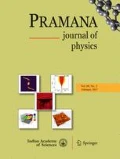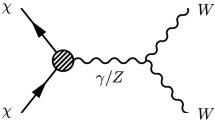Abstract
We consider models of light dark matter coupled to quarks through a vector current interaction. For low energies, these models must be treated through the effective couplings to mesons, which are implemented here through the chiral Lagrangian. We find the signals of dark matter annihilation and decay to the light mesons, and find the expected photon spectrum from the decay of the hadrons. We compare the current and future observations, and show that there is a significant discovery reach for these models.



Similar content being viewed by others
References
e-ASTROGAM Collaboration: A De Angelis et al, arXiv:1711.01265 [astro-ph.HE]
AMEGO Team: R Caputo et al, PoS ICRC 2017, 910 (2017), https://doi.org/10.22323/1.301.0910
J H Buckley and APT Collaboration, The Advanced Pair Telescope (APT) Mission Concept, in AAS/High Energy Astrophysics Division #10, vol. 10, p. #37.04. Mar., 2008.
K K Boddy and J Kumar, Phys. Rev. D 92(2), 023533 (2015), https://doi.org/10.1103/PhysRevD.92.023533, arXiv:1504.04024 [astro-ph.CO]
K K Boddy and J Kumar, AIP Conf. Proc. 1743, 020009 (2016), https://doi.org/10.1063/1.4953276, arXiv:1509.03333 [astro-ph.CO]
K K Boddy, K R Dienes, D Kim, J Kumar, J C Park and B Thomas, Phys. Rev. D 94(9), 095027 (2016), https://doi.org/10.1103/PhysRevD.94.095027, arXiv:1606.07440 [hep-ph]
R Bartels, D Gaggero and C Weniger, J. Cosmol. Astropart. Phys. 1705(05), 001 (2017), https://doi.org/10.1088/1475-7516/2017/05/001, 1703.02546 [astro-ph.HE]
O Cata, A Ibarra and S Ingenhutt, J .Cosmol. Astropart. Phys. 1711(11), 044 (2017), https://doi.org/10.1088/1475-7516/2017/11/044, 1707.08480 [hep-ph]
M Dutra, M Lindner, S Profumo, F S Queiroz, W Rodejohann and C Siqueira, J. Cosmol. Astropart. Phys. 1803, 037 (2018), https://doi.org/10.1088/1475-7516/2018/03/037, arXiv:1801.05447 [hep-ph]
J Kumar, arXiv:1808.02579 [hep-ph]
D Choudhury and D Sachdeva, 1903.06049 [hep-ph]
C Terschlusen, S Leupold and M F M Lutz, Eur. Phys. J. A 48, 190 (2012), https://doi.org/10.1140/epja/i2012-12190-6, arXiv:1204.4125 [hep-ph]
J Gasser and H Leutwyler, Nucl. Phys. B 250, 465 (1985) J Gasser and H Leutwyler, Ann. Phys. 158, 142 (1984) U G Meissner, Rep. Prog. Phys. 56, 903 (1993), hep-ph/9302247 G Ecker, Prog. Part. Nucl. Phys. 35, 1 (1995), hep-ph/9501357 A Pich, Rep. Prog. Phys. 58, 563 (1995), hep-ph/9502366 G Colangelo and G Isidori, hep-ph/0101264 S Scherer, Adv. Nucl. Phys. 27, 277 (2003), hep-ph/0210398
C Terschlusen and S Leupold, Phys. Rev. D 94(1), 014021 (2016), https://doi.org/10.1103/PhysRevD.94.014021, arXiv:1603.05524 [hep-ph]
Particle Data Group: M Tanabashi et al, Phys. Rev. D 98, 030001 (2018)
M Cirelli et al, J. Cosmol. Astropart. Phys. 1103, 051 (2011), Erratum: J. Cosmol. Astropart. Phys. 1210, E01 (2012), https://doi.org/10.1088/1475-7516/2012/10/E01, https://doi.org/10.1088/1475-7516/2011/03/051, arXiv:1012.4515 [hep-ph]
A Geringer-Sameth, S M Koushiappas and M Walker, Astrophys. J. 801(2), 74 (2015), https://doi.org/10.1088/0004-637X/801/2/74, arXiv:1408.0002 [astro-ph.CO]
A W Strong, I V Moskalenko and O Reimer, Astrophys. J. 613, 962 (2004), https://doi.org/10.1086/423193 [astro-ph/0406254]
A Geringer-Sameth and S M Koushiappas, Phys. Rev. Lett. 107, 241303 (2011), https://doi.org/10.1103/PhysRevLett.107.241303, arXiv:1108.2914 [astro-ph.CO]
M N Mazziotta, F Loparco, F de Palma and N Giglietto, Astropart. Phys. 37, 26 (2012), https://doi.org/10.1016/j.astropartphys.2012.07.005, arXiv:1203.6731 [astro-ph.IM]
A Geringer-Sameth, S M Koushiappas and M G Walker, Phys. Rev. D 91(8), 083535 (2015), https://doi.org/10.1103/PhysRevD.91.083535, arXiv:1410.2242 [astro-ph.CO]
K Boddy, J Kumar, D Marfatia and P Sandick, Phys. Rev. D 97(9), 095031 (2018), https://doi.org/10.1103/PhysRevD.97.095031, arXiv:1802.03826 [hep-ph]
HAWC Collaboration: A Albert et al, Astrophys. J. 853(2), 154 (2018), https://doi.org/10.3847/1538-4357/aaa6d8, arXiv:1706.01277 [astro-ph.HE]
T R Slatyer, Phys. Rev. D 87(12), 123513 (2013), https://doi.org/10.1103/PhysRevD.87.123513, arXiv:1211.0283 [astro-ph.CO]
Planck Collaboration: N Aghanim et al, 1807.06209 [astro-ph.CO]
CRESST Collaboration: H Kluck et al,arXiv:1711.01285 [astro-ph.IM]
S Chang, J Liu, A Pierce, N Weiner and I Yavin, J. Cosmol. Astropart. Phys. 1008, 018 (2010), https://doi.org/10.1088/1475-7516/2010/08/018, 1004.0697 [hep-ph]
J L Feng, J Kumar, D Marfatia and D Sanford, Phys. Lett. B 703, 124 (2011), https://doi.org/10.1016/j.physletb.2011.07.083, arXiv:1102.4331 [hep-ph]
J L Feng, J Kumar and D Sanford, Phys. Rev. D 88(1), 015021 (2013), https://doi.org/10.1103/PhysRevD.88.015021, arXiv:1306.2315 [hep-ph]
WASA-at-COSY Collaboration: P Adlarson et al, Phys. Lett. B 770, 418 (2017), https://doi.org/10.1016/j.physletb.2017.03.050, arXiv:1610.02187 [nucl-ex]
K K Boddy, K R Dienes, D Kim, J Kumar, J C Park and B Thomas, Phys. Rev. D 95(5), 055024 (2017), https://doi.org/10.1103/PhysRevD.95.055024, arXiv:1609.09104 [hep-ph]
Acknowledgements
The authors are grateful to James H Buckley, Regina Caputo and Xerxes Tata for useful discussions. JK is supported in part by DOE grant DE-SC0010504. AR is supported in part by NSF Grant PHY-1620638.
Author information
Authors and Affiliations
Corresponding author
Appendices
Appendix A. Decay spectra at rest
We begin by finding the decay spectrum at rest for the various mesons. For two-body decays the spectra are set by kinematics. For a decay \(A\rightarrow B+C\) the energy spectrum of B is
Three-body decays must be analysed in terms of Dalitz plots, which encode the amplitudes as a function of the kinematic variables.
1.1 Appendix A.1. \(K^+(p_K)\rightarrow {{\bar{\ell }}}(p_1)\nu (p_2)\pi ^0(p_3)\)
The decay to \(K^+(p_K)\rightarrow {{\bar{\ell }}}(p_1)\nu (p_2)\pi ^0(p_3)\) is controlled by the matrix element \({{\mathcal {M}}}=(p_K+p_3)^\mu {\bar{\ell }}\gamma _\mu (1-\gamma _5)\nu \). The pion energy spectrum is controlled by
We then find that
where we have defined
1.2 Appendix A.2. \(K^+(p_K)\rightarrow \pi ^0(p_1)\pi ^0(p_2)\pi ^+(p_3)\)
The decay \(K^+(p_K) \rightarrow \pi ^{0}(p_1)\pi ^{0}(p_2)\pi ^{+}(p_3)\) can be expressed in terms of the invariant amplitude \(\mathcal {A}\) [15]
where
The pion energy distribution is then
We then find that the energy distribution of \(\pi _0\) in decays of \(K^+\rightarrow \pi ^{0}\pi ^{0}\pi ^{+}\) at rest is (here \(E_2\) is the neutral pion energy)
where
and
We find that the normalisation constant by integrating both sides with respect to dE (picking up a factor of \(-{1}/{2 m_{K_{+}}}\)). The normalisation constant is given by
1.3 Appendix A.3. \(K_L(p_K) \rightarrow \pi ^{+}(p_1)\pi ^{-}(p_2)\pi ^{0}(p_3), \pi ^{0}(p_1)\pi ^{0}(p_2)\pi ^{0}(p_3)\)
The decay \(K_L(p_K) \rightarrow \pi ^{+}(p_1)\pi ^{-}(p_2)\pi ^{0}(p_3)\) can be expressed in terms of the invariant amplitude \({{\mathcal {A}}}\) [15]
Here
The pion energy distribution is then (here \(E_3\) is the neutral pion energy)
We then find that the energy distribution of \(\pi _0\) in decays of \(K_L \rightarrow \pi ^{+}\pi ^{-}\pi ^{0}\) at rest is proportional to
where
For the \(K_L \rightarrow 3\pi ^0\) decay, we have [15]
where \(h=0.59\). The energy distribution may then be found similarly to the calculation for \(K_L \rightarrow \pi ^+\pi ^-\pi ^0\) above.
1.4 Appendix A.4. \(\omega \rightarrow \pi ^0(p_1)\pi ^+(p_2)\pi ^-(p_3)\)
\(\omega \) decays to three pions are described by a similar Dalitz plot, which was taken from [30].
Appendix B. Boosting the decay spectrum
We now describe the general procedure to obtain the boosted spectrum from the decay spectrum at rest.
We consider a particle of mass m which decays into a number of daughter particles, and we assume that the kinematic distribution of the decay is known in the rest frame of the particle. Our goal is to determine the kinematic distribution in the lab frame, where the parent particle is moving. We take the parent particle to be travelling along the z-axis, with an energy \(E_m\), corresponding to a Lorentz factor \(\gamma =E_m/m\). We assume that there is no correlation between the direction of the daughter particle’s momentum and the direction of the parent particle’s boost.
In the CM frame, the four-momentum of one of the daughter particles is \((E', p'\sin \theta ', 0, p'\cos \theta ')\). We are given \({\mathrm {d}P / \mathrm {d}E'}\) in the CM frame; i.e. the probability of obtaining in the CM frame a given value of the daughter particle’s energy. In the lab frame, the four-momentum is \((E, p\sin \theta , 0, p\cos \theta )\). We are looking for \({\mathrm {d}P / \mathrm {d}E}\).
For the daughter particle in the lab frame, we have
For any given E, this equation has a solution for \(\cos \theta \) if \(E'\) lies in the range
The kinematic distribution of the daughter particle in the laboratory frame is then
where \(E_2=\gamma (E+p\beta )\) and \(E_1=\gamma (E-p\beta )\). This formula allows us to obtain the boosted spectrum from the decay spectrum at rest.
If we assume that the parent particle itself has a kinematic distribution in the laboratory frame given by \(\mathrm {d}N_m / \mathrm {d}E_m\), we then find
Moreover, if the daughter particle itself decays isotropically to some tertiary product, one can determine kinematic distribution of this tertiary product by simply repeating the above process, treating the daughter particle now as the parent to the tertiary particle.
We can apply this formalism to the case of \(\pi ^0\), whose dominant decay is to two photons. In the rest frame, the photons have back-to-back momenta and the distribution is \(\mathrm {d}P /\mathrm {d}E'=2\delta (E'-{m_\pi \over 2})\), where the factor of two accounts for the two photons. We then find
This reproduces the usual box distribution.
If the \(\pi ^0\) injection spectrum is given by \(\mathrm {d}N_\pi / \mathrm {d}E_\pi \), then we may express the photon spectrum as [31]
This implies that the photon spectrum is log-symmetric about \(m_\pi /2\) with a global maximum at that point. Moreover, the spectrum decreases monotonically as the energy either increases or decreases away from \(m_\pi /2\). We see these features in figure 1.
The last thing which is needed is \(\mathrm {d}N_\pi / \mathrm {d}E_\pi \). This can be determined from the procedure described above, treating \(\pi ^0\) as the daughter produced by the decay of \(K_L\), \(K_S\), \(K^\pm \), \(\rho ^\pm \) and \(\omega \). But there is one subtlety to note. This approach is strictly valid only if there is no correlation between the pion boost and the boost of the parent. This is necessarily true if the parent has spin-0, but need not be true if the parent is a vector meson. But we shall assume that this effect is negligible, and ignore it henceforth.
Rights and permissions
About this article
Cite this article
Berger, D., Rajaraman, A. & Kumar, J. Dark matter through the quark vector current portal. Pramana - J Phys 94, 133 (2020). https://doi.org/10.1007/s12043-020-01995-w
Received:
Revised:
Accepted:
Published:
DOI: https://doi.org/10.1007/s12043-020-01995-w



